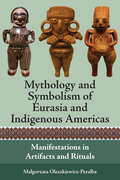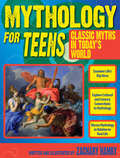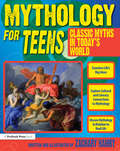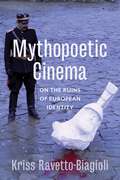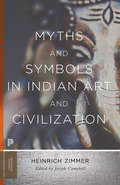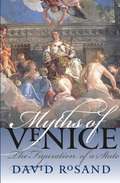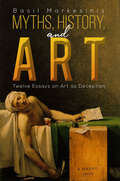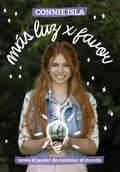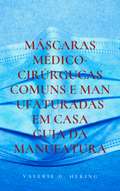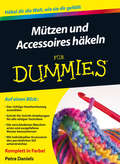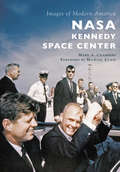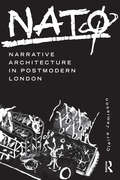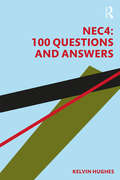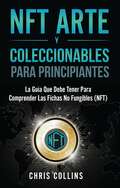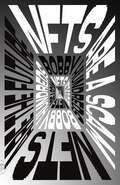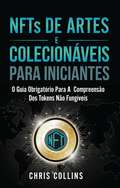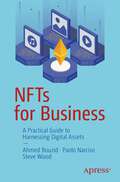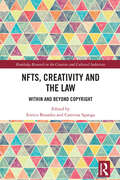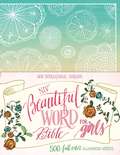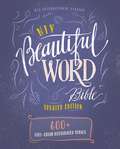- Table View
- List View
Mythology and Symbolism of Eurasia and Indigenous Americas: Manifestations in Artifacts and Rituals
by Małgorzata Oleszkiewicz-PeralbaA system of myths, symbols, and rituals, dating back to the Paleolithic and Neolithic, survives in present-day imagery. In exploring this system, special attention is drawn to the linkage between ancient and contemporary civilizations of Eurasia and Mesoamerica, as seen in their cosmology, and expressed in common mythological and iconographic themes. The author examines contemporary Middle American and eastern European textiles, especially women’s garments, that contain an elaborated sacred code of symbols, and include remnants of the four horizontal directions, and the three vertical worlds that portray the structure of the universe. The cosmology contained in patterns around the world denotes striking parallels that attest to internal connections between different cultures, beyond time and place.
Mythology for Teens: Classic Myths for Today's World
by Zachary HambyMythology for Teens: Classic Myths in Today's World takes classical mythology to a new level by relating ancient stories to the culture, history, art, and literature of today. By looking at topics instrumental to both mythology and modern culture, teens are encouraged to question topics such as the repercussions of war, vanity and greed, the workings of fate, the nature of love, the roles of women in society, revenge and forgiveness, the meaning of life, and national identity. The majority of high school humanities and Advanced Placement courses teach classical mythology by simply retelling myths. By using teen-friendly reader?s theater scripts to tell the legends, in combination with activities, discussion questions, and exercises that help students apply what they've learned to real life, Mythology for Teens takes the classic myths taught in school and turns them into an engaging, interesting, and fresh way of looking at old material.
Mythology for Teens: Classic Myths in Today's World (Grades 7-12)
by Zachary HambyMythology for Teens: Classic Myths in Today's World takes classical mythology to a new level by relating ancient stories to the culture, history, art, and literature of today. By looking at topics instrumental to both mythology and modern culture, teens are encouraged to question topics such as the repercussions of war, vanity and greed, the workings of fate, the nature of love, the roles of women in society, revenge and forgiveness, the meaning of life, and national identity. The majority of high school humanities and Advanced Placement courses teach classical mythology by simply retelling myths. By using teen-friendly reader's theater scripts to tell the legends, in combination with activities, discussion questions, and exercises that help students apply what they've learned to real life, Mythology for Teens takes the classic myths taught in school and turns them into an engaging, interesting, and fresh way of looking at old material. Grades 7-12
Mythopoetic Cinema: On the Ruins of European Identity
by Kriss Ravetto-BiagioliIn Mythopoetic Cinema, Kriss Ravetto-Biagioli explores how contemporary European filmmakers treat mythopoetics as a critical practice that questions the constant need to provide new identities, a new Europe, and with it a new European cinema after the fall of the Soviet Union. Mythopoetic cinema questions the perpetual branding of movements, ideas, and individuals. Examining the work of Jean-Luc Godard, Alexander Sokurov, Marina Abramović, and Theodoros Angelopoulos, Ravetto-Biagioli argues that these disparate artists provide a critical reflection on what constitutes Europe in the age of neoliberalism. Their films reflect not only the violence of recent years but also help question dominant models of nation building that result in the general failure to respond ethically to rising ethnocentrism.In close readings of such films as Sokurov's Russian Ark (2002) and Godard's Notre Musique (2004), Ravetto-Biagioli demonstrates the ways in which these filmmakers engage and evaluate the recent reconceptualization of Europe's borders, mythic figures, and identity paradoxes. Her work not only analyzes how these filmmakers thematically treat the idea of Europe but also how their work questions the ability of the moving image to challenge conventional ways of understanding history.
Myths and Symbols in Indian Art and Civilization (Princeton Classics #111)
by Heinrich Robert ZimmerA landmark work that demystifies the rich tradition of Indian art, Myths and Symbols in Indian Art and Civilization analyzes key motifs found in legend, myth, and folklore taken directly from the Sanskrit. It provides a comprehensive introduction to visual thinking and picture reading in Indian art and thought. Ultimately, the book shows that profound Hindu and Buddhist intuitions on the riddles of life and death are universally recognizable.
Myths of Sexuality: Representations of Women in Victorian Britain
by Lynda NeadA scholarly examination of Victorian attitudes towards women, as expressed in art, literature, and law.
Myths of Venice: The Figuration of a State
by David Rosand<p>Over the course of several centuries, Venice fashioned and refined a portrait of itself that responded to and exploited historical circumstance. Never conquered and taking its enduring independence as a sign of divine favor, free of civil strife and proud of its internal stability, Venice broadcast the image of itself as the Most Serene Republic, an ideal state whose ruling patriciate were selflessly devoted to the commonweal. All this has come to be known as the "myth of Venice." <p>Exploring the imagery developed in Venice to represent the legends of its origins and legitimacy, David Rosand reveals how artists such as Gentile and Giovanni Bellini, Carpaccio, Titian, Jacopo Sansovino, Tintoretto, and Veronese gave enduring visual form to the myths of Venice. He argues that Venice, more than any other political entity of the early modern period, shaped the visual imagination of political thought. This visualization of political ideals, and its reciprocal effect on the civic imagination, is the larger theme of the book.</p>
Myths, History, and Art: Twelve Essays on Art as Deception
by Basil MarkesinisSir Basil Markesinis has held tenured senior posts at the Universities of Cambridge, Oxford, University of London, Leiden (in the Netherlands) and the Law School of the University of Texas at Austin where he is now Emeritus Professor of Comparative Methodology. He has also held for a number of years part-time Chairs at the Universities of Paris I (Sorbonne), Paris II (Assas), Munich (Germany), Ghent (Belgium), Siena, Genova, and Rome (Italy), the Michigan Law School (at Ann-Arbour) for two years and the Cornell Law School for four years. He has authored or co-authored 56 books, over 150 legal articles, and close to 100 articles on geopolitical issues in journals and newspapers in three continents. His most-recent work is his three-volume illustrated treatise entitled Ancient Greek Poetry from Homer to Roman Times, Jan Sramek, Verlag (2017). His academic work has earned him Fellowships at the Academies of Athens, Belgium, Britain, France, the Netherlands, Rome (Lincei), as well as the Athens Archaeological Society and the American Law Institute. For his work in promoting international relations and the study of various European Cultures, especially through his creation of the Leiden Institute of Anglo-American Law (in 1987); The Oxford Institute of European and Comparative Law (in 1996) of which he was Founder, fund raiser, and first Director; and the Texas Institute of Global Law (in 2000), he was awarded the Insignia of the Knight Grand Cross of the Order of Merit of the Republic of Italy; the Knight Grand Cross of the Order of Merit of the Republic of France; the Insignia of the Grand Cross of Service with Star of the Republic of Germany, as well as the insignia of Commander of the Order of the Légion d' honneur of France. In 1997 on the recommendation of the Lord Chancellor, he was appointed Hon. Queen's Counsel; and in 2005, on the advice of the Prime Minister, he was knighted by H. M. Queen Elizabeth II for "exceptional services to international relations."
Más luz x favor: Tenés el poder de cambiar el mundo
by Connie IslaUna de las influencers veganas argentinas de mayor crecimiento cuenta su viaje profundamente personal, un recorrido que va desde su temprana pasión por distintas formas de expresión artística hasta su experiencia de autodescubrimiento y su entrega completa a la causa feminista y a la lucha por un estilo de vida sustentable. Hola. Soy Connie, y quiero agradecerte que tengas mi libro en tus manos. Vengo a proponerte que me acompañes en un viaje, un viaje personal y revelador. Un recorrido por algunas cosas que hice en mi vida, gracias a las cuales me caí, me levanté, reflexioné, aprendí, cambié y entendí que está en nuestras manos hacer de este un mundo mejor. Y que para eso primero es necesario estar dispuestos a conocer, a cuestionarnos y saber algunas cosas que a veces preferiríamos no saber: de dónde viene eso que comemos, quién hizo las prendas con las que nos vestimos, cuánto tarda en degradarse esa botella de plástico que usamos y desechamos, y por qué a veces miramos para otro lado cuando se nos presenta esa verdad incómoda. Espero que acá encuentres no sólo respuestas, sino también preguntas, así como también herramientas para ayudarte a transitar este camino largo pero poderoso. Porque la información es poder, y tenemos el poder de cambiar el mundo. Sí, vos, una sola persona, aunque te cueste creerlo. Cada pequeña acción cuenta. Necesitamos acercarnos un poco más. Tener más compasión. Más conciencia. Más empatía. Más amor. Más luz, por favor.
Máscaras Médico-Cirúrgucas Comuns e Manufaturadas em Casa: Guia da Manufatura
by Valerie D. HeringSurgiu uma necessidade imperial para todos - amigos, familiares, amigos, nós próprios, a comunidade em geral - de nos protegermos através de práticas de responsabilidade cívica e de prevenção individual e coletiva. O uso de uma máscara facial é uma das formas mais significativas de alcançar esse objetivo, muito em particular depois do mundo inteiro ter sido afetado pela atual pandemia infecciosa viral. Estamos, atualmente, a experienciar os efeitos devastadores provocados por um surto epidémico que resultou num número considerável de casos infetados e tem conduzido o mundo inteiro a uma escassez de materiais vitais no combate a esta pandemia, logo a adesão em massa à produção de máscaras médico-cirúrgicas tornou-se uma necessidade acrescida. A produção de máscaras faciais não significa somente dar um passo importante em direção a um fururo promissor. Traduz-se num ato refletido em prol da proteção de toda a humanidade contra vírus e bactérias nocivas à saúde populacional. Esta não é uma missão impossível, é uma prevenção que poderá assegurar através da produção de máscaras eficazes, ao recorrer a um processo que pode ser realizado em apenas alguns minutos. Este livro faculta determinados detalhes, extremamente valiosos, relativamente à manufatura das máscaras cirúrgicas e fornece instruções simples, com ilustrações, para que qualquer pessoa possa aprender a fazer a sua própria máscara em casa. Salienta, ainda, dados importantes acerca dos principais surtos virais transmitidos por via respiratória, respetivas formas de prevenção e outros pontos relevantes acerca do uso correto e adequado das máscaras faciais médico-cirúrgicas, com ou sem acessório respirador. As máscaras cirúrgicas comuns minimizam o risco de contágio contra infeções virais e bacteriológicas transmitidas por via respiratória. Note porém que o uso das máscaras faciais caseiras não protege contra infecções respiratórias vi
Mützen und Accessoires häkeln für Dummies (Für Dummies)
by Petra DanielsVon Arbeitsfaden bis Zählmuster – so geht Ihnen nichts durch die Maschen Sie wollen nun auch trendige Mützen und Accessoires häkeln? Dann ist dieses Buch genau das richtige für Sie. Mit vielen Schritt-für-Schritt-Anleitungen führt Petra Daniels Einsteiger in die Grundlagen des Häkelns ein. Sie lernen alle nötigen Techniken, um die verschiedenen Projekte nacharbeiten zu können – vom Klassiker Zipfelmütze über bunte Beanies bis zu Schals, Taschen, Westen und Deko-Elementen. Wer die Grundlagen beherrscht, steigt bei seinem Wissensstand ein oder frischt seine Kenntnisse auf. Neue Ideen werden auch Fortgeschrittene frisch inspirieren. Informationen über Material und Zu - behör sowie viele Tipps zu Häkeltechniken runden das Buch ab.
NASA Kennedy Space Center (Images of Modern America)
by Mark A. Chambers Michael CurieFrom Bumper V-2 rocket launches in 1950 to the launch of the Orion spacecraft atop a Delta IV rocket in 2014, NASA's Kennedy Space Center has served as the nation's portal to outer space for over 60 years. Images of Modern America: NASA Kennedy Space Center provides a fascinating look at the evolution of spacecraft technology and vintage images of Florida's scenic Merritt Island, known as the "Space Coast." This photographic history of the nation's premier spaceport looks back at the United States' glorious past in space exploration and ahead to its future.
NATØ: Narrative Architecture in Postmodern London
by Claire JamiesonChronicling the last radical architectural group of the twentieth century – NATØ (Narrative Architecture Today) – who emerged from the Architectural Association at the start of the 1980s, this book explores the group’s work which echoed a wider artistic and literary culture that drew on the specific political, social and physical condition of 1980s London. It traces NATØ’s identification with a particular stream of post-punk, postmodern expression: a celebration of the abject, an aesthetic of entropy, and a do-it-yourself provisionality. NATØ has most often been documented in reference to Nigel Coates (the instigator of NATØ), which has led to a one-sided, one-dimensional record of NATØ’s place in architectural history. This book sets out a more detailed, contextual history of NATØ, told through photographs, drawings, and ephemera, restoring a truer polyvocal narrative of the group’s ethos and development.
NCFE Level 1/2 Technical Award in Business and Enterprise
by Tess Bayley Leanna OliverBuild your knowledge and develop the practical enterprise skills you need to achieve the Level 1/2 Technical Award with this brand new textbook, endorsed by NCFE and written by business and enterprise experts Tess Bayley and Leanna Oliver.- Access the information you need using the clear and attractive layout. - Test your knowledge and understanding, with activities and Test Yourself questions throughout.- Reinforce the knowledge and skills you need for both the written exam and synoptic project.- Endorsed by NCFE for the 2018 specification, which is approved for inclusion in the 2020, 2021 and 2022 Key Stage 4 performance tables.
NCFE Level 1/2 Technical Award in Business and Enterprise
by Tess Bayley Leanna OliverBuild your knowledge and develop the practical enterprise skills you need to achieve the Level 1/2 Technical Award with this brand new textbook, endorsed by NCFE and written by business and enterprise experts Tess Bayley and Leanna Oliver.- Access the information you need using the clear and attractive layout. - Test your knowledge and understanding, with activities and Test Yourself questions throughout.- Reinforce the knowledge and skills you need for both the written exam and synoptic project.- Endorsed by NCFE for the 2018 specification, which is approved for inclusion in the 2020, 2021 and 2022 Key Stage 4 performance tables.
NCFE Level 1/2 Technical Award in Business and Enterprise Second Edition
by Tess Bayley Leanna OliverThis Student Textbook is:- Comprehensive - gain in-depth knowledge of each content area with clear explanations of every concept and topic and easy-to-follow chapters.- Accessible, reliable and trusted - structured to match the specification and provide you with the information you need to build knowledge, understanding and skills.- Designed to support you - boost your confidence when tackling the internal non-examined and external examined assessments with plenty of activities to test and consolidate knowledge.- Your go-to guide - expert authors have carefully designed tasks and activities to build your skillset in order to aid progression and questions to assess understanding.
NCFE Level 1/2 Technical Award in Business and Enterprise Second Edition
by Tess Bayley Leanna OliverThis Student Textbook is:- Comprehensive - gain in-depth knowledge of each content area with clear explanations of every concept and topic and easy-to-follow chapters.- Accessible, reliable and trusted - structured to match the specification and provide you with the information you need to build knowledge, understanding and skills.- Designed to support you - boost your confidence when tackling the internal non-examined and external examined assessments with plenty of activities to test and consolidate knowledge.- Your go-to guide - expert authors have carefully designed tasks and activities to build your skillset in order to aid progression and questions to assess understanding.
NEC4: 100 Questions and Answers
by Kelvin HughesThis book details some of the most important and interesting questions raised about the NEC4 family of contracts and provides clear, comprehensive answers to those questions. Written by an NEC expert with over 20 years’ experience using, advising and training others, the book has several distinctive features: It covers the whole NEC4 family It is written by a very experienced NEC author who explains sometimes complex issues in a simple and accessible style The questions and answers range from beginner level up to a masterclass level The questions are real life questions asked by actual NEC practitioners on real projects. The book includes questions and answers relating to tendering, early warnings, programme issues, quality management, payment provisions, compensation events, liabilities, insurances, adjudication, termination and much more. It is essential reading for anyone working with the NEC4 family of contracts, whether professionals or students in construction, architecture, project management and engineering.
NFT Arte y Coleccionables: La Guía Imprescindible para Comprender Los Tokens No Fungibles (NFT)
by Chris Collins¿Está buscando aprender cómo sacar provecho de la revolución NFT? ¿Acaba de enterarse de las NFT? ¿Quieres unirte a la locura como artista, jugador o músico? ¿Le resulta difícil encontrar toda la información en el mismo lugar o simplemente es completamente confuso? Si esto te suena, ¡sigue leyendo! NFT Arte y Coleccionables para Principiantes ofrece, información completa sobre esta reciente tendencia rentable. Esta guía habla sobre qué son las NFT y también proporciona una breve historia de su aparición. Después de conocer las NFT, también encontrará información sobre los tokens Ethereum. Estos son los estándares que unen el sistema de coleccionables digitales. El funcionamiento interno de las NFT, junto con su importancia y valor, también se tratan en esta guía detallada. Las áreas de aplicación y usos le brindarán el conocimiento de áreas en las que puede ingresar en esta tendencia digital. Además, la información de este libro también enumera los principales mercados y el proceso de creación de NFT. En este libro también se desmienten varios mitos de las NFT. El arte y los juegos son las áreas más importantes que están surgiendo dentro de la moda de NFT. Esto es particularmente cierto para la industria del juego, ya que permite a personas de todas las edades aprender esta tecnología de una manera nueva y divertida.
NFTs Are a Scam / NFTs Are the Future: The Early Years: 2020-2023
by Bobby HundredsThe nationally bestselling author and streetwear entrepreneur Bobby Hundreds’s manifesto about NFTs, the future of creativity, and bringing his brand and community into the modern digital space.Bobby Hundreds has spent twenty years building his streetwear company, The Hundreds, to be as much a community as a brand. So when Bobby discovered NFTs in 2020, he knew that the technology had the makings of a revolution. Now fans could not only directly support artists and creators but also have a genuine stake in the success of the work. Here, Bobby saw a way for the Hundreds community to participate in the brand as never before. But was this a good idea? Are NFTs truly the future of creativity? Or just a fad? Are they a scam? Maybe they are all those things. In NFTs Are a Scam / NFTs Are the Future, Bobby digs deep into these questions and more: Are NFTs fashion? A cult? Already over? Just beginning? None of the answers are simple, and Bobby works through each with the thoughtfulness and hard-earned insight that have made him a fervently sought-after voice in conversations about creativity, commerce, and community in the digital age. Over the course of just a few years, NFTs have been celebrated and derided; fortunes have been made and lost, empires built and toppled, and Bobby has been, and remains, in the thick of it. For the reader sitting on a collection of NFTs, this is an obvious must-read. For those wondering what’s been going on—and why it’s worth paying attention to—it is the perfect primer.
NFTs de Artes e Colecionáveis para Iniciantes: O Guia Obrigatório para a Compreensão Dos Tokens Não Fungíveis (NFTs)
by Chris CollinsNFTs de Artes e Colecionáveis para Iniciantes por Chris Collins O guia obrigatório para compreender os tokens não fungíveis (NFTs) Este guia fala sobre o que são os NFTs e também fornece um breve histórico de seu surgimento. Você está à procura de aprender como poderá lucrar com a revolução NFT? Você acabou de descobrir sobre os NFTs? Você quer participar desta onda, seja como artista, jogador ou músico? Você está achando difícil encontrar todas as informações no mesmo lugar? Se é isso que você quer, então continue lendo! NFTs de Artes e Colecionáveis para Iniciantes oferece informações abrangentes sobre esta tendência recente e lucrativa. Este guia fala sobre o que são NFTs e também fornece um breve histórico de seu surgimento. Depois de aprender sobre os NFTs, você também encontrará informações sobre os tokens Ethereum. Esses são os padrões que unem o sistema de colecionáveis digitais. O funcionamento interno dos NFTs, juntamente com sua importância e valor, também são abordados neste guia detalhado. As áreas de aplicação e usos proporcionarão o conhecimento do exato ponto em que você pode entrar nesta tendência digital. Além disso, as informações neste livro também listam os principais mercados e o processo de criação de NFTs. Vários mitos sobre NFTs são também desmascarados neste livro. Arte e jogos são as áreas mais importantes que estão surgindo dentro da onda NFT. Isso é particularmente verdadeiro para a indústria de jogos, pois permite que pessoas de todas as idades aprendam essa tecnologia de uma maneira divertida. Neste livro, você descobrirá: Uma maior compreensão sobre NFT e Ethereum Introdução aos termos-chave Riscos envolvidos História e surgimento de NFTs Padrões do Token Ethereum Como funcionam os NFTs Por que os NFTs têm valor Usos dos NFTs Tokens Não Fungíveis, baseados em Blockchain O Merca
NFTs for Business: A Practical Guide to Harnessing Digital Assets
by Steve Wood Ahmed Bouzid Paolo NarcisoMove beyond the tech jargon and the hype of non-fungible tokens (NFT)s and become empowered to think through solutions to solve your specific business problems. NFTs are important because they enable the manipulation of digital assets in ways that are closer to the way we manipulate physical assets. This book will serve as an introduction to the space and as a source of inspiration for connecting problem and solution dots. Understanding what core problems NFTs solve and how they solve them will enable business leaders to design solutions and to put together the teams that will help them deliver on the promises of NFTs. This book is focused on explaining what NFTs are, what problems they solve, and what what technology makes them possible. It provides the larger technological, economic, and political context within which NFTs are emerging. You'll learn how NFTs are currently being used, such as in assessing authenticity, creating scarcity, identifying provenance, establishing and confirming ownership, and enabling the tracking and collection of royalties You'll also see how NFTs allow for the creation of unique digital assets that can be owned and traded just like physical assets. NFTs is your guide to the emerging possibilities of ownership and monetization of digital assets in established industries.What You'll LearnSee what problems NFTs can solveStudy the fundamentals of blockchain technologyUnderstand what “Web3” means and the possibilities ahead Identify problems that NFTs can solve Deliver NFT and blockchain based solutionsWho This Book Is ForEntrepreneurs, executives, and product line managers in the following industries: Art, Music, Podcasting, Gaming, Finance, and Real Estate. Additional audiences include Retail, Fashion, Entertainment, Event Management and Supply Chain Management.
NFTs, Creativity and the Law: Within and Beyond Copyright (Routledge Research in the Creative and Cultural Industries)
by Enrico Bonadio Caterina SgangaNon-Fungible Tokens (NFTs) have emerged as an important medium for the creation, sale and collection of art, with many major business and fashion houses creating their own NFT projects. This book investigates the eruption of NFT crypto art, and its impact on copyright law.Chapters address topics at the intersection between AI, smart contracts, data science, copyright law and arts administration. With snapshots of the ongoing heated debates around copyright law, the book investigates whether NFTs violate copyright and moral rights, the liability of NFTs platforms, impacts on ethical issues such as counterfeiting. The first book published on this emergent topic, this book offers a comprehensive overview of opportunities and challenges raised by NFTs to copyright law and, more generally, to the regulation and economics of the creative and cultural industries.The book is addressed to law and tech enthusiasts as well as academics, students, practitioners and policy makers interested in the intersection between copyright rules and new forms of technology.
NIV Beautiful Word Bible for Girls: 500 Full-Color Illustrated Verses
by ZondervanDiscover God’s Word through gorgeous illustrated verses. Crafted on high-quality paper and balanced with inspiring full-color art and blank space for journaling, the NIV Beautiful Word Bible for Girls encourages girls to spend quiet time with God and his Word. This Bible contains 500 illustrated verses to illuminate the rich stories, characters and hope contained within Scripture. It inspires girls to explore new ways to grow their faith, drawing deeper into God’s life-changing Word.Features include:500 full-color illustrated versesWide margins and high-quality paper for notes, journal entries or artworkIndex of illustrated Scripture passages8-point fontSingle-column text of the New International Version (NIV)
NIV, Beautiful Word Bible, Updated Edition, eBook: 600+ Full-Color Illustrated Verses (Beautiful Word)
by ZondervanBe drawn into God’s Word through a fresh, creative expression of the beautiful words of God.Now refreshed with 100 additional illustrations, the NIV Beautiful Word™ Bible, Updated Edition offers a one-of-a-kind visual treatment of Scripture for a more beautiful quiet time. Find even more beauty in the Word of God as you discover wisdom to sustain you in every season. Be drawn into the splendor of God’s Word with colorful, illustrated verse art and uplifting imagery that complements Scripture.Features include: Single-column text of the accurate, readable, and clear New International Version (NIV)600 full-color illustrated versesIndex of illustrated Scripture passages
